- Submissions

Full Text
Annals of Chemical Science Research
Classification of Environmental Management Types of Coal Development in China Based on Composite Ecosystem Theory
Wen Qiu*, Sishi Cai, Lianhong Lv and Hong Luo
Chinese Research Academy of Environmental Sciences, China
*Corresponding author:Wen Qiu, Chinese Research Academy of Environmental Sciences, Beijing, 100012, China
Submission: August 28, 2025;Published: September 16, 2025

Volume5 Issue1September 16, 2025
Abstract
Energy is an important material basis for the survival and development of human society. Among them, coal resource is one of the important energy mineral resources. In terms of China’s situation, energy development should focus on coal based thermal power production. But the development and utilization of coal will have a serious impact on the ecological environment. At present, China’s total carbon emissions rank first in the world. Therefore, improving energy utilization technology, vigorously developing circular economy, improving energy utilization efficiency and optimizing energy structure are effective methods to solve the environmental problems caused by coal utilization. Coal development environment is a complex ecosystem of nature, society and economy. Based on the development of regional energy, economy, environment and energy economy environment system, this paper studies the theory and technology method system of coal development environment research. The “complex ecosystem theory” is applied to the study of environmental management of coal development. The principal component analysis method combined with fuzzy comprehensive evaluation method is used to comprehensively evaluate the coal development environment in China. The vulnerability types of coal development ecological environment in China are preliminarily divided, and a set of new theory and method system of regional energy and environment regulation based on coal is explored. The results show that the ecological environment of most provinces in China is very fragile. It is suggested that under the premise of doing a good job in project ecological environment impact assessment and ecological environment protection measures, we should try our best to tap the potential of resources and develop them moderately. The division results can provide a reference for China’s ecological environment governance.
Keywords:MXene; Wearable electronics; Health monitoring; Supercapacitors; Flexibility
Abbreviations:Composite ecosystem; Coal development; Environmental management; Ecological vulnerability; Fuzzy comprehensive evaluation
Introduction
Energy is the material basis of economic and social development, among which coal is one of the important basic energies [1]. Coal development will have direct or indirect adverse effects on human health and ecological environment [2], such as depression and anxiety [3], and the emergence of a large number of organic pollutants in the environment of the industrial region [4]. The rational development and utilization of coal resources directly affect the sustainable development of coal industry and environment. The problems in the process of coal development, such as low utilization rate of coal resources, disorderly development, super-intensity mining, air and water pollution, have attracted widespread attention [5-7]. Coal environment is a composite ecosystem of three different properties, which is composed of society, economy and nature. The social ecological subsystem is dominated by human behavior. Economic subsystem is the production, circulation, consumption, reduction and regulation of human beings for their own survival and development. The natural subsystem is composed of water, gas, soil, and life, The environment on which human beings depend on survival and reproduction is formed by the relationship between minerals and their interrelations [8]. The evaluation of coal development complex ecosystem is one of the effective methods for environmental management and control. The energy value theory can be used to evaluate the adverse impact of coal mining on environment and human health [9-10].
British botanist Arthur George Tansley put forward the concept of ecosystem in 1935. He believed that ecosystem is a unity composed of biological community and its natural environment in a certain range of time and space [11]. Professor Ma Shijun, an outstanding ecologist in China, put forward the theory of compound ecosystem in 1981. He pointed out that the natural environment, society and economy on which human beings depend for survival are three different systems. Their survival and development are restricted by the structure and function of other systems. They must be regarded as a compound system, which we call social economic natural compound ecosystem [12]. Many scholars at home and abroad apply the theory of complex ecosystem to environmental research. Yang et al. [13] applied the theory of complex ecosystem to the comprehensive evaluation and management of rice ecosystem sustainability, and found that the anti-interference ability and stability of rice ecosystem in China weakened from 2009 to 2017, and the sustainability of rice ecosystem deteriorated. Wang et al. [14] studied the ecosystem functions of different geomorphic types in Beijing Tianjin Hebei region from 2000 to 2018. The results showed that three key ecosystem service factors: soil erosion, water yield and net primary productivity (NPP) had certain interaction. Pearson coefficient showed that soil erosion and water yield, water yield and NPP had a synergistic relationship, there is a compromise between soil erosion and NPP. The results can provide a reference for the comprehensive evaluation of ecosystem services and the management of ecosystem regionalization. Leijstera et al. [15] studied the ecosystem service function of agroforestry system in Columbia City in recent 40 years. The results showed that the aboveground carbon storage, habitat allocation, timber storage and coffee bean quality all followed a positive asymptotic trajectory. Agroforestry measures can be used to restore the development and sustainable supply of ecosystem services.
However, there are few reports on the theory and method of energy environment complex ecosystem regulation at home and abroad. Heuvel et al. [16] studied the ecosystem services in the relationship of water energy food land climate in Sweden: the interaction of human pressure and physics, focusing on the synergistic effect of Biophysics, socio-economic and social interaction among water, land, energy, food and climate in the level of Biophysics, socio-economic and governance The trade-off between conflict and relevance. Agus et al. [17] studied the organic carbon storage and its dynamics in the ecological restoration area after the open-pit coal mining in the tropical rainforest. The study found that in the tropical rainforest forest ecosystem, the mining of open-pit coal mining is leading to land degradation and destruction, and the extremely degraded area can be restored by reconstructing the fast-growing species and vegetation, It is expected to recover its biomass and organic carbon storage rapidly. Li et al. [18] studied the evolution characteristics of forest spatial pattern in China’s northern coal energy province in the past 30 years, and found that the change of forest spatial pattern is a key process of landscape dynamics, which has an important impact on the changes of forest ecosystem biodiversity, habitat quality and even the overall function. Aggregation index (AI), maximum patch index (LPI), patch density (PD) and shape index (SI) are the four main landscape indicators.
It is of great significance to study the dynamic mechanism and cybernetic method of energy environment complex ecosystem for the sustainable development of China. At present, the research on the evaluation of coordinated development of economy environment society complex ecosystem has gradually changed from qualitative and static analysis to quantitative and dynamic trend evaluation. The evaluation models mainly include inputoutput model [19], EKC econometric model [20], grey system model [21], comprehensive evaluation model of coordinated scheduling and coordinated development degree [22], etc. These models have their own advantages and disadvantages and application scope, which promote the research progress in this field to a certain extent. Composite system is an open, nonlinear, dynamic and complex large-scale system, which involves many objectives and is easily affected by external factors. Different factors also directly affect the results of empirical analysis. According to the above analysis of game and coordination of economic and environmental development, the state or degree of system coordination can be reflected by mathematical model or quantitative method. Based on the principles of comprehensiveness, representativeness, quantification, operability and scientificity, this paper selects appropriate indicators to build an energy environment composite ecosystem evaluation index system.
The research on vulnerable areas of ecosystems can be traced back to 1905, when Clements, an American ecologist, introduced the concept of ecological transition zone into ecological research [23]. Ecosystem vulnerability is the process of any natural and man-made action on the ecological vulnerable zone, which occurs in a certain space and time range [24]. Cao [25] constructed the evaluation index system of ecological vulnerability, constructed the poverty evaluation index system of county level from the social and economic aspects, quantitatively analyzed and discussed the coupling relationship between the two, in order to provide decision-making basis for the study area to strengthen the ecological environment protection. Zhang [26] pointed out that the selection of ecological vulnerability evaluation indicators should be combined with the vulnerability characterization of the study area, and should be scientifically selected from the leading factors leading to vulnerability. Generally, topography, geomorphology, climate, hydrology, soil and geology can be used as potential vulnerability factors. When the degradation of ecological environment exceeds the current level of human utilization and development, we call it fragile ecological environment. The fragile ecological environment seriously restricts the development of regional economy and society, and poses a serious threat to the sustainable development of the region. Therefore, it is of great significance to evaluate the vulnerability of China’s coal development ecological environment concretely and objectively.
Based on the development of regional energy, economy, environment and energy economy environment system, this paper studies the theory and technology method system of coal development environment research. The “complex ecosystem theory” is applied to the study of environmental management of coal development, and an integrated index system of regional energy, environment and economy (3e) regulation is initially established. The principal component analysis combined with fuzzy comprehensive evaluation method is used to comprehensively evaluate China’s coal development environment, and the vulnerability types of China’s coal development ecological environment are preliminarily divided, A new theory and method system of regional energy and environment regulation based on coal is explored.
Research Methods
Research data sources
The data in this paper involve economic, ecological and social systems. The data range is 2010-2020, and the data are mainly from meteorological statistics, forestry statistics yearbook, China Statistics Yearbook, China Energy Yearbook, coal industry statistics yearbook and relevant statistical data of various provinces.
Construction of index system of composite ecosystem
It is very important to build a composite ecosystem evaluation index system for the evaluation of ecological environment vulnerability in China. Based on the availability of data, with reference to the research of Liu et al. [27-29] and combined with the actual situation of the research area in China, from the four dimensions of energy, economy, environment and ecology, this paper selects energy production, energy consumption, economic structure, economic growth, ecological scale, ecological protection and other indicators (Table 1) to build a composite ecosystem evaluation index system.
Table 1:Evaluation index system for regulation and control of regional energy and environment composite ecosystem.
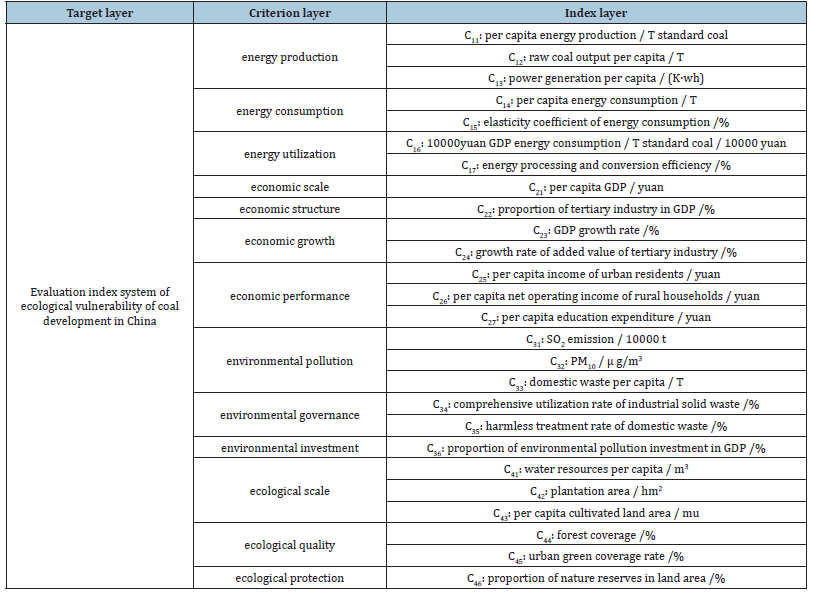
Evaluation model and method Coordination degree analysis of complex ecosystem
Coordination degree is a measure of the degree of harmony between the system or the internal elements of the system in the development process, reflecting the trend of the system from disorder to order. It is a quantitative indicator of the coordination of energy, economy, environment and ecosystem. Referring to the capacity coupling coefficient model in physics, the coupling coordination degree formula of China’s economy ecology environment composite ecosystem is constructed:

Among them, C is the coupling degree, and U1, U2 and U3 are the development indexes of ecological subsystem, economic subsystem and environmental subsystem respectively. The higher the C is, the closer the relationship between the systems is and the stronger the coupling strength is.
Coupling degree can reflect the closeness of each subsystem, but it cannot represent the coordinated development level of complex ecosystem. In order to characterize whether the functional systems are in a high-level promotion state or a low-level constraint state, this paper introduces a coupling coordinated development model. The improved coupling coordination model is as follows:

Where D is the coupling co scheduling, C is the coupling degree, and X is the comprehensive development index of the composite functional system. α, β, γ. For the weight parameters of each subsystem, this paper considers that the ecological subsystem, economic subsystem and environmental subsystem are equally important, so the ecological subsystem is the most important, α=β=γ=1/3, That is, D reflects the development level of complex ecosystem, the higher the better.
Classification of coal reserves
Referring to the relevant statistical data, the statistics of coal reserves in China’s provinces in 2010 are shown in Table 2. At present, there is no unified international classification of coal reserves. Some reserves classifications adopted now are developed on the basis of the three-level classification proposed by Goodwell in 1909 and in combination with their own characteristics.
Table 2:Index weight of regional energy environment composite ecosystem.
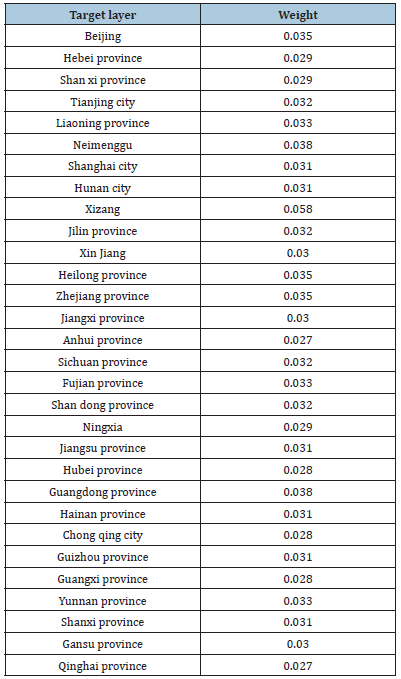
Assessment and prediction of ecological environment vulnerability
Ecological environment vulnerability assessment and prediction [30-31]. Ecological vulnerability assessment includes static assessment and dynamic assessment. The evaluation indexes of ecological vulnerability mainly include productivity index, carrying capacity index and ecological sensitivity index. The main evaluation methods include analytic hierarchy process, principal analytic hierarchy process, fuzzy comprehensive evaluation method, landscape pattern index method, grey relational analysis method, evaluation method based on remote sensing GIS, neural network method, matter-element extension model, etc., and have the trend of diversification, complexity and integration; After the evaluation, they were graded according to the evaluation results. Ecological vulnerability classification is one of the key links to intuitively express the results of ecological vulnerability assessment. The classification is based on ecological threshold and combined with the actual situation of ecological vulnerable areas. The common methods include natural break point method and equal spacing classification method. The main methods of ecological vulnerability prediction include ecological footprint method, scenario analysis method, system dynamics simulation model, 3S technology and so on.
At present, the classification standard of ecological environment vulnerability has not been unified. In this study, the eco-environmental vulnerability assessment is divided into three levels: target level, criterion level and index level; The criteria layer is used to reflect the internal coordination of China’s ecoenvironmental vulnerability, which is composed of four parts: energy, economy, environment and ecology; The index layer reflects the specific indicators of each criterion layer in the evaluation of ecological environment vulnerability, and is composed of 30 specific evaluation indicators reflecting the ecological vulnerability of the study area, which is the basis of the evaluation of ecological environment vulnerability.
Determination of index factor weight
In the evaluation of ecological vulnerability, the selected index
factors have different influence and importance on the ecosystem.
In order to ensure the scientificity of the analysis, the weight
is usually used to express the importance of the indicators. In
this paper, the principal component analysis method is used to
determine the weight of each indicator. The results are shown in
Table 2. From Table 2, it can be seen that the weight value of Xizang
in 31 comments is the highest, which is 0.058.
1) Principal component analysis (PCA): Principal component
analysis (PCA) is based on the relationship between the
various indicators, using the method of dimensionality
reduction to convert multiple indicators into a few unrelated
indicators, so that the next step of research becomes a simple
statistical method. After standardized operation, the data are
dimensionless and can be evaluated and analyzed.
2) Spss19 statistical analysis software was used to conduct
principal component analysis on the above 30 evaluation
factors. The results are shown in Table 3.
Table 3:Characteristic value, contribution rate and cumulative contribution rate of each component in fragile ecosystem of coal development in China.

The above table analyzes the situation of principal component
extraction and the information amount of principal component
extraction. It can be seen from Table 3 that three principal
components were extracted by principal component analysis,
and the eigenvalue values were all greater than 1. The variance
interpretation rates of these three principal components were
89.621%, 94.098%, 97.838% respectively, and the cumulative
variance interpretation rate was 97.838%. In addition, three
principal components were extracted in this analysis and their
corresponding weights were 89.621/97.838=91.60%; 4.476/
97.838 = 4.58%; 3.740/97.838=3.82%; This shows that 97.838% of
the information provided by the ecological vulnerability evaluation
index can be reflected, which summarizes the main information of
the original index, and also conforms to the principle of principal
component extraction with the cumulative variance contribution
rate of more than 80%; At the same time, it also shows that the
principal component analysis method is reliable to evaluate the
environmental ecological vulnerability of China’s coal development.
3) Table 4 shows the initial factor load matrix, that is, the factor
load coefficient divided by the square root of the corresponding
characteristic root.
Table 4:Factor load matrix analysis results.
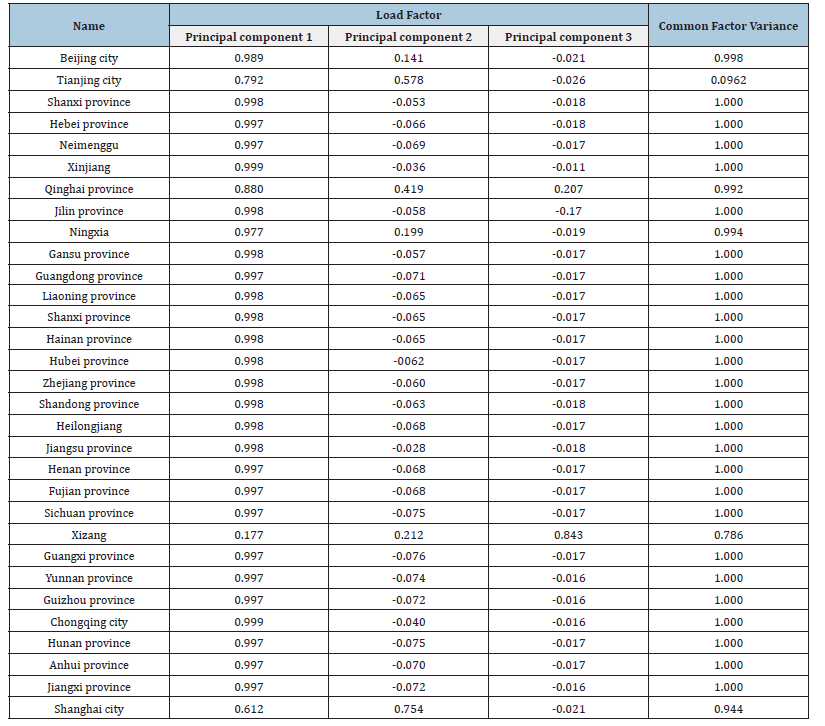
4) The comprehensive score coefficient is calculated, that is, the linear combination coefficient is multiplied by the variance interpretation rate and then accumulated and divided by the cumulative variance interpretation rate; Calculate the weight and normalize the comprehensive score coefficient to get the weight value of each index. The calculation results are shown in Table 5.
Table 5:Comprehensive evaluation results of ecological vulnerability of coal development in China.
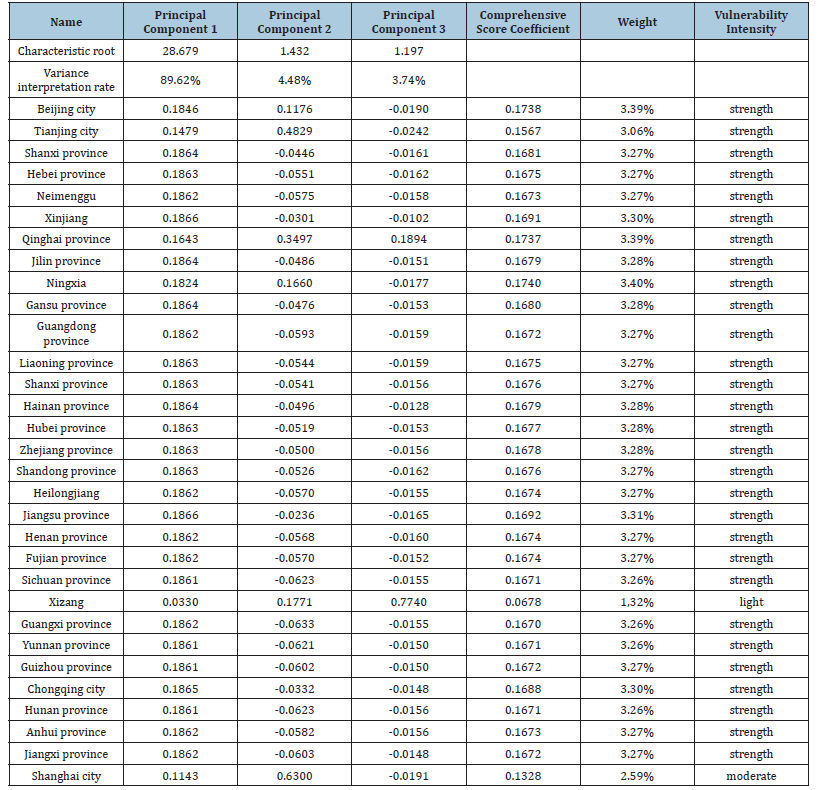
5) Fuzzy comprehensive evaluation: This study mainly adopts fuzzy comprehensive evaluation method [32], which transforms qualitative evaluation into quantitative evaluation according to the membership theory of fuzzy mathematics, that is, to make an overall evaluation of things or objects restricted by many factors with fuzzy mathematics. The fuzzy comprehensive evaluation of the results of principal component analysis is carried out, and the evaluation results are realized with the help of statistical analysis software spss19.0.
In the quantitative evaluation of fragile ecological environment, the index system is established and weighted to calculate the vulnerability g of each province. In this paper, based on the principal component analysis method to determine the weight of each index, the fuzzy comprehensive evaluation method is used to analyze the ecological environment vulnerability of China’s coal development. Referring to Hu et al. [33-34] on the classification method of ecological environment vulnerability evaluation in Weifang City, the evaluation grade standard is divided. According to the results of principal component analysis, 31 provinces and cities are divided into three categories according to the degree of vulnerability; The area with G greater than 0.10 and less than 0.15 is moderately vulnerable; The area with g less than 0.10 is considered to be slightly vulnerable. The results are shown in Table 6.
Table 6:Evaluation results of ecological vulnerability.

Data standardization
Because the dimension and magnitude of the original data are non-uniform, the original data must be standardized. After data standardization, the index value is between 0 and 1.
Results and Analysis
Coordination degree analysis of complex ecosystem
Coordination degree is a measure of the degree of harmony between the system or the internal elements of the system in the development process, reflecting the trend of the system from disorder to order. It is a quantitative indicator of the coordination of energy, economy, environment and ecosystem. Referring to the capacity coupling coefficient model in physics, the coupling coordination degree formula of China’s economy ecology environment composite ecosystem is constructed. The coordination coupling degree of 21 provinces and cities in China is calculated, and the results are shown in Table 7. The larger the C value of coupling degree in different regions, the greater the interaction between the systems; The larger the D value of coupling coordination degree is, the higher the coordination degree is. As can be seen from Table 7, the coupling coordination level of China’s economy society environment composite ecosystem is high, which is high quality coordination.
Table 7:calculation results of coupling coordination degree of different regions in 2010.
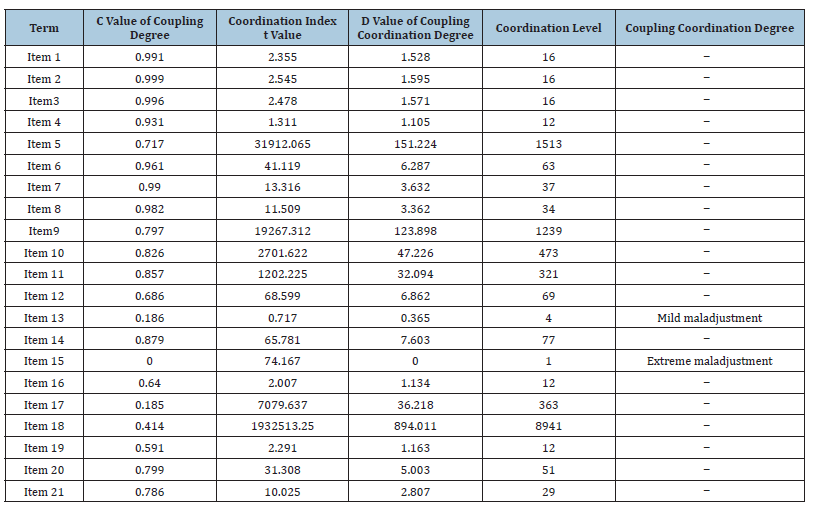
Classification of coal reserves
With reference to the relevant statistical data, the statistics of coal reserves of China’s provinces in 2010 are shown in Table 8. According to the degree of investigation and research, China’s coal reserves can be divided into a, B, C and D levels. Among them, Grade A and B are called advanced reserves. In this paper, according to 100 ~ 6.5 billion tons, 2.5 ~ 6.5 billion tons, 0 ~ 2.5 billion tons of coal reserves are classified into high, medium and low reserves.
Table 8:Coal resource reserves of China’s provinces.
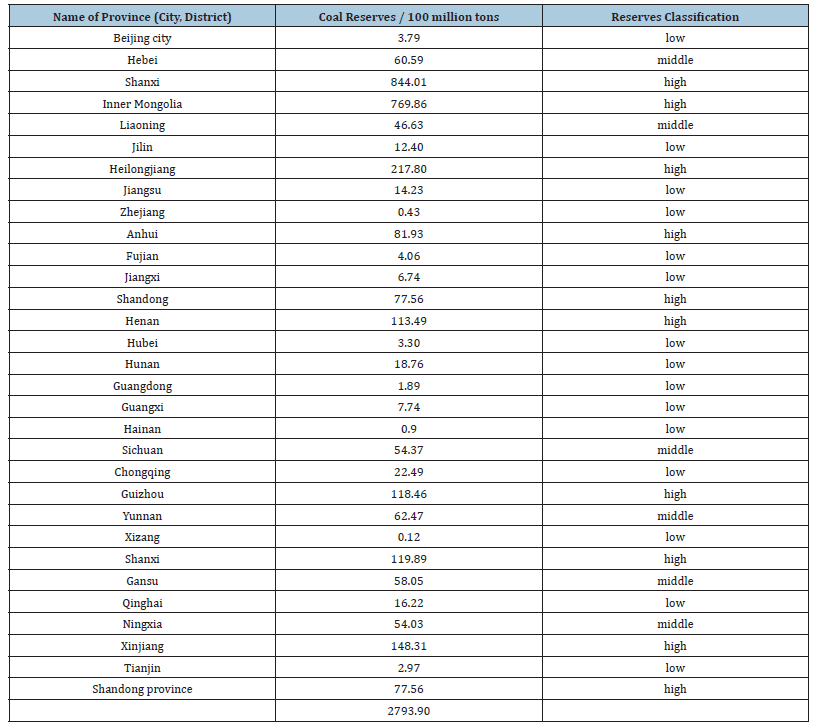
Division of coal development environmental management type area
To improve China’s ecological carrying capacity and ensure ecological security, based on the theory of composite ecosystem, this paper preliminarily divides China’s coal development reserves and ecological environment vulnerability types, and puts forward differentiated environmental management requirements and suggestions for different ecological vulnerability control areas. The results are shown in Table 9.
Table 9:Environmental management zoning and control requirements for coal development.
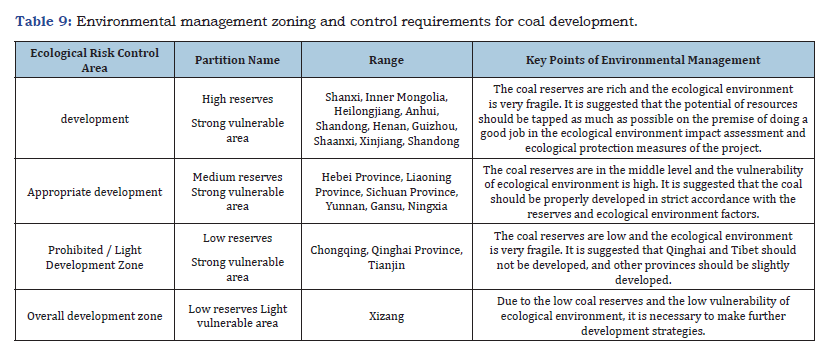
Conclusion and Suggestion
The fragile ecological environment is the result of the longterm
interaction between natural factors and human activities. In
order to realize the sustainable development of social economy, it
is necessary to coordinate the ecological environment protection
and social economic development. Based on the theory of complex
ecosystem, this paper divides the environmental management
area of coal development in China. According to the types of ecoenvironmental
vulnerability in different regions of China, a new
theory and method system of regional energy and environmental
regulation based on coal is explored. It is suggested that the
prevention and control of environmental pollution should be carried
out according to the goal of “taking improving environmental
quality as the core”. The following conclusions are drawn from the
management of energy and environment in China
1) In view of the slowdown of China’s economic growth and the
reduction of energy consumption dependence on coal, considering
the environmental carrying capacity of coal development, it is
suggested to appropriately adjust the mining intensity of China’s
coal resources.
2) Sustainable development has increasingly become the ideal
goal of development and environmental management, and the
measurement or evaluation of sustainable development is one of
the important issues.
3) In this paper, the “complex ecosystem theory” is applied to
the study of environmental management of coal development. The
principal component analysis combined with fuzzy comprehensive
evaluation method is used to make a comprehensive evaluation
of China’s coal development environment, and the vulnerability
types of China’s coal development ecological environment are
preliminarily divided.
4) According to the comprehensive evaluation results of the
ecological environment vulnerability of the study area, aiming at
the existing resources and environmental problems in the region,
this paper puts forward the strategy of insisting on sustainable
development and differentiated environmental management
requirements, so as to protect China’s ecological environment.
Acknowledgement
Fund Project: Basic research business project of central public welfare research institutes (no.2019ysky001) Supported by Basic Scientific Research Funds in National Nonprofit Institutes, China (No.2019YSKY001).
References
- Alyeksandr A, Bai Z Q, Bai J, Janchig N, Barnasam P, et al. (2021) Thermal behavior of Mongolian low-rank coals during pyrolysis. Carbon Resources Conversion 4: 19-27.
- Li X, Jiang T, Sun X, Yong X, Ma X, et al. (2020) The relationship between occupational stress, musculoskeletal disorders and the mental health of coal miners: The interaction between BDNF gene, TPH2 gene polymorphism and the environment. Journal of Psychiatric Research 135: 76-85.
- Smits J, Ederveen T, Schalkwijk J, van Hijum S, Zeeuwen P, et al. (2018) 966 The human cutaneous microbiome composition changes after coal tar treatment of both healthy and atopic dermatitis skin. Journal of Investigative Dermatology 138(5): 164.
- Nádudvaria Á, Fabiańska MJ, Marynowski L, Kozielska B, konieczynski J, et al. (2018) Distribution of coal and coal combustion related organic pollutants in the environment of the Upper Silesian Industrial Region. Science of The Total Environment 628-629: 1462-1488.
- Feng Y, Lu JJ, Wang JC, Mi J, Zhang M, et al. (2020) Desulfurization sorbents for green and clean coal utilization and downstream toxics reduction: A review and perspectives. Journal of Cleaner Production 273: 123080.
- Li J, Wang J (2019) Comprehensive utilization and environmental risks of coal gangue: A review. Journal of Cleaner Production 239: 117946.
- Zhou Y, Zi T, Huang D, Wei P, Chen D, et al. (2020) Impact of rural residential coal combustion on air pollution in Shandong, China. Chemosphere 260: 127517.
- Wang GC, Li PF, Wang H, Li GJ (2015) Assessments of integrated ecosystems in mining areas based on emergy analysis. Acta Ecologica Sinica 35(13): 4367-4376.
- Andreotti F, Mao Z, Jagoret P, Speelman EN, Gary C, et al. (2018) Exploring management strategies to enhance the provision of ecosystem services in complex smallholder agroforestry systems. Ecological Indicators 94(Part 1): 257-265.
- Pan Z, He J, Liu D, Wang J, Guo X (2021) Ecosystem health assessment based on ecological integrity and ecosystem services demand in the Middle Reaches of the Yangtze River Economic Belt, China. Science of The Total Environment 774: 144837.
- Tansley SA (1988) The status of threatened proteaceae in the Cape Flora, South Africa, and the implications for their conservation. Biological Conservation 43(3): 227-239.
- Ma SJ, Wang RS (1984) The social-economic-natural complex ecosystem. Acta Ecologica Sinica 4(1): 1-9.
- Yang T, Sun YH, Li XL, Li Q (2021) An ecosystem elasticity perspective of paddy ecosystem sustainability evaluation: The case of China. Journal of Cleaner Production 295: 126292.
- Wang H, Liu LB, Yin L, Shen J, Li SC, (2021) Exploring the complex relationships and drivers of ecosystem services across different geomorphological types in the Beijing-Tianjin-Hebei region, China (2000-2018). Ecological Indicators 121: 107116.
- Leijster VD, Santos MJ, Wassen MW, Camargo Garcia JC, Llorca Fernandez I, et al. (2021) Ecosystem services trajectories in coffee agroforestry in Colombia over 40 years. Ecosystem Services 48: 101246.
- Heuvel LVD, Blicharska M, Masia S, Susnik J, Teutschbein C (2020) Ecosystem services in the Swedish water-energy-food-land-climate nexus: Anthropogenic pressures and physical interactions. Ecosystem Services 44: 101141.
- Agus C, Putra PB, Faridah E, Wulandari D, Richard RP Napitupulu (2016) Organic carbon stock and their dynamics in rehabilitation ecosystem areas of post open coal mining at tropical region. Procedia Engineering 159: 329-337.
- Li Y, Liu ML, Liu XN, Yang W, Wang WW (2021) Characterising three decades of evolution of forest spatial pattern in a major coal-energy province in northern China using annual Landsat time series. International Journal of Applied Earth Observation and Geoinformation 95: 102254.
- Malik A, Egan M, Plessis MD, Lenzen M (2021) Managing sustainability using financial accounting data: The value of input-output analysis. Journal of Cleaner Production 293: 126128.
- Ulucak R, Bilgili F (2018) A reinvestigation of EKC model by ecological footprint measurement for high, middle and low income countries. Journal of Cleaner Production 188: 144-157.
- Wang ZX, Jv YQ (2021) A non-linear systematic grey model for forecasting the industrial economy-energy-environment system. Technological Forecasting and Social Change 167: 120707.
- Yang WC, Xu K, Lian JJ, Bin L, Ma C (2018) Multiple flood vulnerability assessment approach based on fuzzy comprehensive evaluation method and coordinated development degree model. Journal of Environmental Management 213: 440-450.
- Zhang XL, YU WB, Cai HS, Guo XM (2018) Review of the evalutaion methods of regional eco-environmental vulnerability. Acta Ecologica Sinica 38(16): 5970-5981.
- Mahapatra M, Ramakrishnan R, Rajawat AS (2015) Coastal vulnerability assessment using analytical hierarchical process for South Gujarat coast, India. Natural Hazards 76(1): 139-159.
- Cao SS, Wang YH, Duan FZ, Zhao WJ, Wang ZH, et al. (2016) Coupling between ecological vulnerability and economic poverty in contiguous destitute areas, China: Empirical analysis of 714 poverty-stricken counties. Chinese Journal of Applied Ecology 27(8): 2614-2622.
- Zhang XL, Yu WB, Cai HS, Guo XM (2018) Review of the evaluation methods of regional eco-environmental vulnerability. Acta Ecologica Sinica 38(16): 5970-5981.
- Liu JP, Tian Y, Huang K, Yi T (2021) Spatial-temporal differentiation of the coupling coordinated development of regional energy-economy-ecology system: A case study of the Yangtze River economic belt. Ecological Indicators 124: 107394.
- Shen W, Zheng ZC, Pan L, Qin Y, Ki Y (2021) A integrated method for assessing the urban ecosystem health of rapid urbanized area in China based on SFPHD framework. Ecological Indicators 121: 107071.
- Tian P, Wu HQ, Yang TT, Jiang F, Zhang W, et al. (2021) Evaluation of urban water ecological civilization: A case study of three urban agglomerations in the Yangtze River Economic Belt, China. Ecological Indicators 123: 107351.
- Shang YR (2000) New progress of comprehensive research on natural disasters: Vulnerability research. Regional research and development 19(2): 73-77.
- Fang CL, Wang Y, Fang JW (2016) A comprehensive assessment of urban vulnerability and its spatial differentiation in China. Journal of Geographical Sciences 26(2): 153-170.
- Zhao YL, Zhang CS, Wang YX, Lin H (2021) Shear-related roughness classification and strength model of natural rock joint based on fuzzy comprehensive evaluation. International Journal of Rock Mechanics and Mining Sciences 137: 104550.
- Hu XJ, Ma CM, Huang P, Guo X (2021) Ecological vulnerability assessment based on AHP-PSR method and analysis of its single parameter sensitivity and spatial autocorrelation for ecological protection-A case of Weifang City, China. Ecological Indicators 125: 107464.
- Tang Q, Wang JM, Jing ZH (2021) Tempo-spatial changes of ecological vulnerability in resource-based urban based on genetic projection pursuit model. Ecological Indicators 121: 107059.
© 2025 Wen Qiu. This is an open access article distributed under the terms of the Creative Commons Attribution License , which permits unrestricted use, distribution, and build upon your work non-commercially.
 a Creative Commons Attribution 4.0 International License. Based on a work at www.crimsonpublishers.com.
Best viewed in
a Creative Commons Attribution 4.0 International License. Based on a work at www.crimsonpublishers.com.
Best viewed in 







.jpg)






























 Editorial Board Registrations
Editorial Board Registrations Submit your Article
Submit your Article Refer a Friend
Refer a Friend Advertise With Us
Advertise With Us
.jpg)






.jpg)














.bmp)
.jpg)
.png)
.jpg)










.jpg)






.png)

.png)



.png)






